Four Minutes Thirty-Three Seconds
“He tried to gather up and hold the phrase or harmony… that was passing by him and that opened his soul so much wider, the way the smells of certain roses circulating in the damp evening air have the property of dilating our nostrils.”— Marcel Proust, Swann’s Way
Places have signature colors, they inscribe themselves onto you in liquid strokes of a pen you never quite see until the ink rolls down your forehead and covers your eyes with a thin veil, the mist through which you come to see a place. A place, a scene on a street, a city, a whole country, colors your memory like a child’s crayon scribbling across your pupils. Jaisalmer India looks reddish brown and pink in my memory, Laos a dusty beige mist, Ko Kradan Thailand a green and blue cloak… and Prague was a pale yellow just this side of ochre.
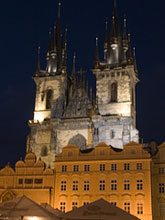 It started from the moment we drove into town. Mildly lost, displaced and confused by road construction, we passed by a yellow building several times. I cannot say exactly why I noticed this yellow building over a thousand other, and perhaps more striking details, but it is the yellow building I remember.
It started from the moment we drove into town. Mildly lost, displaced and confused by road construction, we passed by a yellow building several times. I cannot say exactly why I noticed this yellow building over a thousand other, and perhaps more striking details, but it is the yellow building I remember.
And once the building lodged itself in my mind I seemed to develop some heightened observational acuity for the color yellow — stale champagne flat in its flute, crushed threads of saffron in little tins at the market, primrose blooms in a window planter, lotus in a pond, cough syrup for a child, ecru linen on the laundry line, tarnished gold lamps languishing unused in the dark corners of a hotel room, gilded Torah scrolls, the jaundiced skin of a Golem, faded magazines at the newsstand, sunflowers in a store window, chicken skin on the chopping block and a thousand other snapshots tinted yellow.
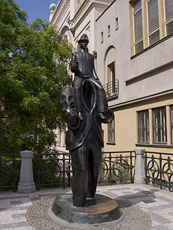 I read somewhere that yellow daffodils are a symbol of unrequited love. An agreed upon meaning for yellow buildings has thus far remained elusive in my research. Which is to say I never looked into it; I am content with the simplicity of memory unencumbered by meaning. Memory is a strange and mysterious thing, not to be fully trusted. For instance I can’t say for sure, but I feel like I saw yellow daffodils in the New Jewish Cemetery near the grave of Franz Kafka, but it’s entirely possible I invented this detail on reflection.
I read somewhere that yellow daffodils are a symbol of unrequited love. An agreed upon meaning for yellow buildings has thus far remained elusive in my research. Which is to say I never looked into it; I am content with the simplicity of memory unencumbered by meaning. Memory is a strange and mysterious thing, not to be fully trusted. For instance I can’t say for sure, but I feel like I saw yellow daffodils in the New Jewish Cemetery near the grave of Franz Kafka, but it’s entirely possible I invented this detail on reflection.
Whatever the case I do know that Prague was home to Franz Kafka, a man who has in death assumed a life so large his last name is an adjective in common parlance, Kafkaesque—an adjective I’m pretty sure I’ve used somewhere in these very pages.
I made a cursory visit to Kafka’s tomb, just as I did to Proust’s in Pere Lechaise, compelled by some sense of validation, as if standing in front of these slabs of granite one can finally feel like one has reached the end of the literary journey and yet knowing that in fact not only is that not true, but just the opposite is true. As with any journey made mainly in the mental space of books and stories, the infringement of the real into the world of the imagination was wholly disappointing. Kafka’s grave is unremarkable in every way, a stone monument 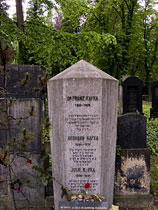 standing over a patch of grass beneath which lies what at this point probably little more than dust and teeth, not unlike the dusty yellowing pages of Kafka’s books mingling with the old stained-ivory smell of dust mites and dry rot in the musty air of libraries.
standing over a patch of grass beneath which lies what at this point probably little more than dust and teeth, not unlike the dusty yellowing pages of Kafka’s books mingling with the old stained-ivory smell of dust mites and dry rot in the musty air of libraries.
I have spent and still do spend, a fair amount of my time lost in books, stories and poems. One of my favorite lines from Kafka addresses literature as “a hatchet with which we chop at the frozen seas inside us.”
Someone recently wrote me an email asking me to spend more time talking about places and less time in these abstractions, talking about perhaps nothing at all. A Hemingway fan no doubt. I hate to disappoint, but I seem to feel the need to wield a hatchet against my own icy seas. It is tempting to extend Kafka’s analogy in this day and age when there actually is a northwest passage and the literal ice of our seas melts with every passing day, but what I personally find compelling about Kafka’s words is the absolute futility they imply. He could for instance have said a hatchet which chops at the frozen blocks of ice inside us, certainly that would imply some chance of success, but he did not. He wrote “frozen seas,” against which a hatchet is most certainly futile.
Futile but important, for without the hatchet there is no hope at all. And I think Kafka would agree with the notion that while literature may be a hatchet, there are other tools available, the important thing is to chop at the frozen seas, lest they overwhelm us and freeze our souls. And by soul I mean something akin to what I believe James Brown probably meant, something that is at once within us and outside us, something that does not seem to yellow with the passing of time, but as many believe, shall even outlast our teeth, our bones, our history far past the time when we are only a name in someone else’s memory.
Just north of Prague’s old town square and east of the River Vltava is Josefov, the old Jewish quarter of Prague. The Pinkas Synagogue on Siroka Street in Josefov is an unassuming pale, sand-colored building with a slightly sunken entrance. Inside is a small alter and little else. The floor is bare; there are no places for worshipers to sit. The synagogue is little more than walls. And on the walls inscribed in extremely small print are the names of the 77,297 Jewish citizens of Bohemia and Moravia who died in the Holocaust.
It is a stark place and yet not cold. It has a calmative warmth beneath the monstrousness of what it bears witness to that seems somehow hopeful in spite of the past. Some might believe that it is time to move beyond the Holocaust, time to forget, but they are wrong. It is important that we do not forget the Holocaust of World War Two nor any of the many that have happened since. It is important to remember these atrocities not because that might prevent another, which as we surely must realize by now is wishful thinking, 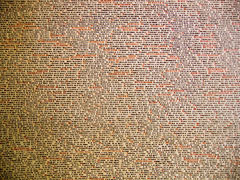 but because those who died ought to be remembered as everyone who has died ought to be remembered, not for how they died, but for who they were. The Pinkas synagogue reminds us not of the deaths of the victims, but of the lives they once had, reduced here to their essence, their names.
but because those who died ought to be remembered as everyone who has died ought to be remembered, not for how they died, but for who they were. The Pinkas synagogue reminds us not of the deaths of the victims, but of the lives they once had, reduced here to their essence, their names.
Upstairs in the Pinkas Synagogue there is an exhibit of paintings done by the children in Theresienstadt (originally named Terezin), paintings that resemble the ones on your refrigerator if you have children or the ones your parents once hung on their refrigerator, except that these were painted by children awaiting transportation to the gas chamber.
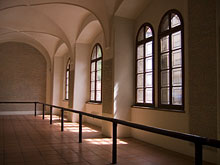 It’s easy to get rather angry at humanity when confronted with such things, but I stood there thinking instead that those children, young as they were and headed to a fate none of us can imagine, nevertheless managed to produce beautiful finger and brush paintings. Perhaps they were too young to realize what was happening to them, perhaps they were too innocent to conceive of such a thing happening, but what if they did know? What if they knew full well that they were going to die and yet they went on anyway, painting and being children because there was nothing else they could do? Because there is nothing else any of us can do.
It’s easy to get rather angry at humanity when confronted with such things, but I stood there thinking instead that those children, young as they were and headed to a fate none of us can imagine, nevertheless managed to produce beautiful finger and brush paintings. Perhaps they were too young to realize what was happening to them, perhaps they were too innocent to conceive of such a thing happening, but what if they did know? What if they knew full well that they were going to die and yet they went on anyway, painting and being children because there was nothing else they could do? Because there is nothing else any of us can do.
Chopping. Chopping. Chopping.
[Today’s title comes from a composition by John Cage. For those that aren’t familiar with Cage or the piece, 4‘33” is a piece of music in which the pianist comes on stage, opens the lid of the piano and sits down to play. For 4 minutes and thirty-three seconds he plays nothing. He then closes the piano, bows and walks offstage.
You can see where it would be tempting to see this as a somewhat pretentious intellectual exercise, but as with Duchamp’s Fountain, I think to see this as only as some challenge to our accepted notions is simple minded. Of course it flies in the face of convention, but it also does much more.
Music, rhythm, harmony, melody and all its other components are capable of inducing all sorts of amazing things in us, both beautiful and terrifying which as Proust says in the quote that started this piece, widens our soul. So what happens when the music is not music, but an absence of music? What Cage has done is handed us Kafka’s hatchet, in 4‘33” the chopping of the frozen seas is left to the individual.
I’ve never actually seen 4‘33” performed, but I would venture to say that it isn’t silent. While the performer may not make any noise, there will likely be plenty of noise, traffic outside the theatre, a airplane passing overhead, perhaps the wail of an ambulance siren, and even inside—the ruffling of programs and papers of fellow concert goers shifting in their seats, the creaks and groans of humanity sitting still, perhaps even the sound of blood rushing through your veins and throbbing in your eardrums.
Unlike most public performances, 4‘33” is intensely personal. There is no hatchet save the one in your own hand and perhaps 4‘33“‘s poor reception in some quarters comes from the fact that confronting the frozen seas alone is a desolate and intimidating experience, one we often shrink from in fear. But if the children of Terezin were capable of joy in the face of such a monstrosity, surely we can find a similar kind of hope.
I can’t explain what it’s like to stand in a place like Pinkas Synagogue or the killing fields or S21 or any other memorial of mass slaughter, but I can say this, there was no music and yet nor was there silence.]
Thoughts?
Please leave a reply:
All comments are moderated, so you won’t see it right away. And please remember Kurt Vonnegut's rule: “god damn it, you’ve got to be kind.” You can use Markdown or HTML to format your comments. The allowed tags are
<b>, <i>, <em>, <strong>, <a>. To create a new paragraph hit return twice.